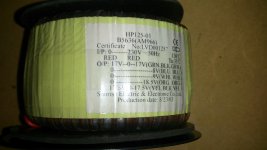Yes. Look up a schematic for the equipment it came out of.
I wish I'd thought of that . . .
You can *measure* it under working conditions.
Connect main winding, the 34V CT one to a large diode bridge, say a typical 35A (or so) one so it´s out of the equation, to a , say, 4700uFx50V capacitor, and measure DC voltage.
You´ll get some 48V DC.
Now load output with increasing loads (decreasing resistance).
You can make cheap disposable load resistors out of sections of nichrome heater wire,

cut to desired resistive value and attached to parallel rows screws on a piece of wood, with a bathroom tile between wire and wood so wire does not burn it.
Sort of similar to this but horizontal (easier).

Something similar to this but with wire sections in parallel.
Make each section 20 ohm, which will take 125W nominal.
They will become very hot, "shouldn´t" become red hot like these, but no big deal if they do, this is an estimation, not a *precise* measurement.
Connect 1-2-3-4 in succession in parallel , starting with one, of course, so you´ll be loading your transformer with roughly 125 - 200 - 300 W, and so on.
When DC voltage drops by 20%, so under 40V, that´s the practical limit of your transformer.
Junk the cheesy kludged load resistor, it´s served its purpose, anyway you spent 10-15 bucks-quid tops.
What´s slang for Euro?
No need to leave load ON for hours, just 1 or 2 minutes to measure DC under load for each value.
Remember to fuse transformer primary (say 5 or 6A fuse), just in case.
Connect main winding, the 34V CT one to a large diode bridge, say a typical 35A (or so) one so it´s out of the equation, to a , say, 4700uFx50V capacitor, and measure DC voltage.
You´ll get some 48V DC.
Now load output with increasing loads (decreasing resistance).
You can make cheap disposable load resistors out of sections of nichrome heater wire,

cut to desired resistive value and attached to parallel rows screws on a piece of wood, with a bathroom tile between wire and wood so wire does not burn it.
Sort of similar to this but horizontal (easier).

Something similar to this but with wire sections in parallel.
Make each section 20 ohm, which will take 125W nominal.
They will become very hot, "shouldn´t" become red hot like these, but no big deal if they do, this is an estimation, not a *precise* measurement.
Connect 1-2-3-4 in succession in parallel , starting with one, of course, so you´ll be loading your transformer with roughly 125 - 200 - 300 W, and so on.
When DC voltage drops by 20%, so under 40V, that´s the practical limit of your transformer.
Junk the cheesy kludged load resistor, it´s served its purpose, anyway you spent 10-15 bucks-quid tops.
What´s slang for Euro?
No need to leave load ON for hours, just 1 or 2 minutes to measure DC under load for each value.
Remember to fuse transformer primary (say 5 or 6A fuse), just in case.
Last edited:
clay pot load resistor ...cool!
my go to are some 200 watt crane brake resistors also ceramic....
my go to are some 200 watt crane brake resistors also ceramic....
Thanks guys, but this is sounding long and involved. I have a TPA3116D2 and bridge rectifier kicking about somewhere. My guess is that it'll either work or it won't, right?
No, my guess is it may work then burn your house down some day....
But analytically - 17.5Vac CT will give approx +/-25Vdc - into a typical speaker (6 ohm) thats about 4Adc or about 3Aac at the secondary.
But analytically - 17.5Vac CT will give approx +/-25Vdc - into a typical speaker (6 ohm) thats about 4Adc or about 3Aac at the secondary.
Weigh it and compare to catalog transformers.
It will certainly "work" at idle. How bad will it sag at full roar? If you get stoned and blast it all night long, will it melt and stink? Guessing through the internet is maybe the second worst way to determine tranny ability.
It will certainly "work" at idle. How bad will it sag at full roar? If you get stoned and blast it all night long, will it melt and stink? Guessing through the internet is maybe the second worst way to determine tranny ability.
> It weighs 2Kg.
150VA-180VA.
Hammond Mfg. - Toroid Power Transformer - (182 Series)
Hammond Mfg. - Toroid Power Transformers - (1182 Series)
150VA-180VA.
Hammond Mfg. - Toroid Power Transformer - (182 Series)
Hammond Mfg. - Toroid Power Transformers - (1182 Series)
- Home
- Amplifiers
- Power Supplies
- Estimating Transformer Output (Amps) . . . again.
